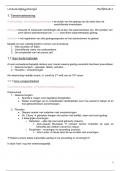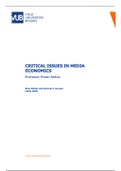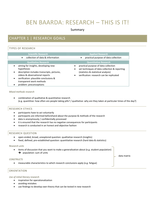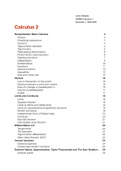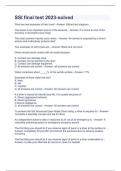Chapter 1: The General Framework
The course objective is to understand how to use derivatives to fit (almost) any desired payoff
profile. Structured products are synthetic investment instruments that are specially created to meet
specific needs that cannot be met from the standardized financial instruments available in the
markets. Structured products can be used:
• as an alternative to a direct investment;
• as part of the asset allocation process to reduce risk exposure of a portfolio;
• or to utilize the current market trend.
Derivatives structuring is about solving problems. The natural building blocks of the derivatives
structurer are cash flows, which are payments from one counterparty to another. These are
characterized by 1) the amount to be exchanged and 2) the data on which the exchange takes place.
A fixed cash flow concerns the exchange of a prefixed amount, while with an index-linked cash flow
the amount to be exchanged depends on the future value of one or more variables; the reference
indices (or seen as risk factors). The goal of the derivatives structurer is to package fixed and/or
index-linked cash flows together in such a way that the risks are correctly hedged.
The most popular reference indices to link cash flows to are therefore market prices, such as stock
prices, bond prices, interest rates, exchange rates and commodity prices. One may also derive new
indices from these price levels. Apart from market prices, derivatives structures may also use other
economic variables as reference indices, such as stock market indices, macro-economic price indices,
credit ratings or the occurrence of a default or a takeover. A third group of indices consists of non-
economic variables, such as the outcome of a lottery or the rainfall or temperature.
It is typically not possible to say exactly when a reference index will realize its next value. However,
when structuring a derivatives contract the times and dates on which the reference index is to be
monitored are fixed in advance. What is being monitored though is not the index value pricelessly at
these monitoring poi8nbts, but the last realized value.
The easiest way to create an index-linked cash flow is to simply make the cash flow equal to the
value of the reference index on the payment date. There are however three possible problems:
• Monetization: the first problem is that the reference index may not be expressed in money
terms. To solve this problem, we implicitly multiply non-money indices by a monetizer.
• Currency translation: the reference index may not be denominated in the currency in which
we want to get paid. The solution is the introduction of an explicit currency translator which
converts the index currency into the payment currency. One may use the spot rate for this,
or a prefixed exchange rate, the average exchange rate, lowest/highest over some period,
and so on. Reference indexes are monetized before they are currency translated. Monetizing
directly into the payment currency is different from first monetizing into the index currency
and then converting the index currency into the payment currency. Monetizing directly into
the payment currency is the same as converting at a prefixed exchange rate.
• Scaling: a third problem concerns the size of the cash flow. A cash flow equal to the value of
the reference index will typically only be small, but we can simply multiply the index value by
a fixed multiplier. Multiplying the index by a multiplier generally works well, except with cash
flows linked to interest rates. Because interest rates tend to be expressed on an annual basis,
cash flows linked to interest rates are typically expressed as the product of 1) a multiplier, 2)
a day count fraction and 3) an annualized interest rate. Different markets tend to work with
different day count conventions.
Vanilla cash flows, he most basic or standard version of a financial instrument, can be combined into
more complex cash flows using a number of operations in any combination one sees fit. For example,
,one could equal the cash flows to the sum, the difference between two cash flows, the product or
ratio of two cash flows or the highest of lowest or two or more cash flows. With structured cash flows
it is important to note that when it comes multiplication and currency translation every component
cash flow in the package comes with its own multiplier and currency translator. If one would not do
this, part of the available flexibility is lost.
Confronted with a problem, we first identify the relevant reference indices and payment dates.
Subsequently, we hook up the cash flows on those payment dates with the reference indices and
package all cash flows into a single contract. These can be classified into two different groups:
• Index-linked notes: a zero-coupon note is to pay the cash to some counterparty in return for
a single payment by that counterparty in the future. These can be linked to indices as well.
• Forwards and swaps: often the best solution to a problem is to trade in one cash flow for
another. Such contracts are known as forwards. This can be extended into a multi-period
setting, which is called swaps. A swap is a derivative contract through which two parties
exchange the cash flows or liabilities from two different financial instruments.
The counterparty paying the fixed cash flow(s) (under a swap/forward contract) is the byer and the
one paying the index-linked cash flow(s) is the seller.
Sometimes one can do even better by including one or more additional rights or restrictions. Despite
the obvious importance of tax, accounting and regulation, we will largely ignore these issues.
There are a number of difference between trades on exchanges and over the counter (OTC):
Characteristic Exchanges Over the counter (OTC)
Trading Centralized Decentralized
Transparency High Low
Credit risk Low (clearing house) Depends on counterparty
Contracts Standardized Flexible
Liquidity High Variable
Participants Wide range Wholesale
There are a number of advantages of derivatives markets over cash markets:
• Lower transaction costs
• Better liquidity
• Possibility to trade exposures not easily available in the cash market (e.g. Indexes)
• Leverage: margin requirements are a fraction of the value of the exposure (5% on
average)
• Ease of going short (no need to borrow the asset)
• Price discovery is often performed in derivatives markets rather than in cash markets
There are liquidity issues in different markets. In futures markets, liquidity is concentrated around
short time-to-maturity contracts and in options markets, liquidity is concentrated around ATM
options. Liquidity can be measured by open interest and trading volume.
Some advanced trading techniques are:
• Spreading: taking offsetting positions in derivatives contracts on:
o the same underlying asset but with different characteristics (such as maturity, strike)
o different but related underlying assets
, • Cross margining: recognizing the partial offset of positions and lowering margins
requirements. Goal: increase leverage. Can be performed across spot and futures markets as
well.
• Spread futures based on the difference between two related products (e.g. crack spread - in
commodity markets, the spread created by purchasing oil futures and offsetting the position
by selling gasoline and heating oil futures. The name of this strategy is derived from the fact
that "cracking" oil produces gasoline and heating oil).
Functions of clearing house:
• Back office services: Record keeping & clearing and settlement (completion of payment
flows)
• Netting: Contractual offset of payables against receivables to reduce credit exposure to a
counterparty.
• Guaranty: clearing house is counterparty in every trade. To protect itself, the clearing house
imposes margin requirements.
Standardization of OTC products (master agreements) result in a market in between OTC and
organized markets. Trading can be done via blind broker screens. Both dealers and brokers should
maintain the confidentiality of the names and identities of parties to any blind brokered trade.
Central clearing and netting services are provided.
Swap notes is a bond future referenced to the swap market. It is exchange - traded and centrally
cleared. As such, it can be viewed as a bond futures contract that is priced in line with the swaps
curve. For example, the Ten-Year € Swapnote® contract is a future on a bond with ten years to
maturity (at the contract’s value date). This bond pays an annual coupon of 6%, and repays the
capital at maturity. In reality, though, this bond does not exist - it is a ‘notional bond’. However,
rather than require delivery of a bond chosen from a specified list, the Swapnote contract is cash
settled against a value calculated by the Exchange. This value is calculated as the present value of the
notional bond’s cash flows - the coupon and capital payments - using zero coupon discount factors
derived from the ISDA® swaps fixings on the contract’s Last Trading Day. Using ISDA® swaps fixings in
this way ensures that the Swapnote contract is valued in line with the swap market - the notional
bond has the credit risk of the inter-bank swaps market. There are a number of benefits resulting
from the fact that Swapnote is a cash settled contract. The settlement price calculation is robust - the
ISDA® figures represent an average of quoted rates from a wide range of sources. With no bond to
deliver, there is no concern over the availability of the bond or over the cost of performing the
delivery process. Similarly, the notional bond has a fixed and standard maturity - were a real bond to
be substituted for delivery, the tenure of the bond would most likely not match that of the future,
creating complications in the calculation of contract value and associated analytics, which don’t exist
with Swapnote.
Liquidity issues:
• In futures markets, liquidity is concentrated around short time-to-maturity contracts
(although not the very short time-to-maturity contracts).
• In option markets, liquidity is concentrated around ATM options.
• Liquidity varies across contract times.
• Measures of liquidity are: open interest (number of contracts alive) and trading volume
Chapter 2: Stocks and Stock Market Indices
, Equity indices are a measurement of (a section of) the stock market. These have some
characteristics:
• Equity indices typically do not include dividends (exception - DAX): Returns based on the
Index are lower than returns of holding the portfolio
• Used as Benchmarks. Some hedge funds aim at replication e.g., Vanguard Index Trust -
500 for the S&P500
• Indices are Trademarks and are licensed by their owners against payment
• Futures and option traded on major indices
• Sub-indices per sector (no derivatives)
Generally speaking, stocks represent an ownership interest in a business entity. There are a number
of different business entities:
• Sole proprietorship: full control of a business and answers to no one but himself. The owner
is liable for the obligations.
• Partnership: a number of people starting a company. The owners are liable for the
obligations.
• Corporation: a legal entity by itself and is therefore clearly distinguishable from its owners.
Owners have limited liability.
Stocks issued by a corporation are known as common stock. Companies typically only issue one class
of common stock, but sometimes they differentiate between class A and B with different voting
and/or dividend rights. Number of shares outstanding does not necessarily have to be higher than
the number of shares issued (as the company may own some of its own shares) and the value of the
shares outstanding is known as the market capitalization. Investing in foreign stocks is used for a very
long time in other countries, but in the US this is relatively new and special trusts have been created
to pass on all distributions related to this trading.
Apart from the stock prices, common stockholders’ wealth is affected by corporate actions. The most
important ones are:
• Dividends: a share of stock has value because the owner of the stock is entitled to receive
dividends. These are paid in many different ways, but cash is the most occurrent one.
• New issues: when companies need money they can decide to issue new stocks. This is either
done through a private placement (separate negotiations) or a public issue (offered on the
market). An underwriter is used to issue the stocks by buying them in the form of a spread
(lower than value at which the stock is sold) so that they make profit, while the company has
less risk. It is possible to issue new shares through a rights issue as well in which the
stockholders might possess a right to buy new stocks at that price. When a new issues is
announced, then the stock is likely to drop as this is a sign of the company needing more
cash.
• Stock splits: when a company’s stock prices rises to a relatively high level it may decide to
split a stock into two or more new stocks to make it easier for small investors to invest in it.
An index number is a number which expresses the ratio between the level of a given variable at one
moment and that of the index’s base value. To calculate the current index value we have to divide
the stock’s current price by its price on an earlier date and multiply by the chose base value. If we
want to keep trach of the development of the stock market as a whole, we can use the same
principle. First, we have to choose the stocks to be included in the average and then we must decide
the weights given to these stocks. These values can either be assigned price-weighted (the higher the
stock price, the higher the weight) or value-weighted (based on market capitalization):
The course objective is to understand how to use derivatives to fit (almost) any desired payoff
profile. Structured products are synthetic investment instruments that are specially created to meet
specific needs that cannot be met from the standardized financial instruments available in the
markets. Structured products can be used:
• as an alternative to a direct investment;
• as part of the asset allocation process to reduce risk exposure of a portfolio;
• or to utilize the current market trend.
Derivatives structuring is about solving problems. The natural building blocks of the derivatives
structurer are cash flows, which are payments from one counterparty to another. These are
characterized by 1) the amount to be exchanged and 2) the data on which the exchange takes place.
A fixed cash flow concerns the exchange of a prefixed amount, while with an index-linked cash flow
the amount to be exchanged depends on the future value of one or more variables; the reference
indices (or seen as risk factors). The goal of the derivatives structurer is to package fixed and/or
index-linked cash flows together in such a way that the risks are correctly hedged.
The most popular reference indices to link cash flows to are therefore market prices, such as stock
prices, bond prices, interest rates, exchange rates and commodity prices. One may also derive new
indices from these price levels. Apart from market prices, derivatives structures may also use other
economic variables as reference indices, such as stock market indices, macro-economic price indices,
credit ratings or the occurrence of a default or a takeover. A third group of indices consists of non-
economic variables, such as the outcome of a lottery or the rainfall or temperature.
It is typically not possible to say exactly when a reference index will realize its next value. However,
when structuring a derivatives contract the times and dates on which the reference index is to be
monitored are fixed in advance. What is being monitored though is not the index value pricelessly at
these monitoring poi8nbts, but the last realized value.
The easiest way to create an index-linked cash flow is to simply make the cash flow equal to the
value of the reference index on the payment date. There are however three possible problems:
• Monetization: the first problem is that the reference index may not be expressed in money
terms. To solve this problem, we implicitly multiply non-money indices by a monetizer.
• Currency translation: the reference index may not be denominated in the currency in which
we want to get paid. The solution is the introduction of an explicit currency translator which
converts the index currency into the payment currency. One may use the spot rate for this,
or a prefixed exchange rate, the average exchange rate, lowest/highest over some period,
and so on. Reference indexes are monetized before they are currency translated. Monetizing
directly into the payment currency is different from first monetizing into the index currency
and then converting the index currency into the payment currency. Monetizing directly into
the payment currency is the same as converting at a prefixed exchange rate.
• Scaling: a third problem concerns the size of the cash flow. A cash flow equal to the value of
the reference index will typically only be small, but we can simply multiply the index value by
a fixed multiplier. Multiplying the index by a multiplier generally works well, except with cash
flows linked to interest rates. Because interest rates tend to be expressed on an annual basis,
cash flows linked to interest rates are typically expressed as the product of 1) a multiplier, 2)
a day count fraction and 3) an annualized interest rate. Different markets tend to work with
different day count conventions.
Vanilla cash flows, he most basic or standard version of a financial instrument, can be combined into
more complex cash flows using a number of operations in any combination one sees fit. For example,
,one could equal the cash flows to the sum, the difference between two cash flows, the product or
ratio of two cash flows or the highest of lowest or two or more cash flows. With structured cash flows
it is important to note that when it comes multiplication and currency translation every component
cash flow in the package comes with its own multiplier and currency translator. If one would not do
this, part of the available flexibility is lost.
Confronted with a problem, we first identify the relevant reference indices and payment dates.
Subsequently, we hook up the cash flows on those payment dates with the reference indices and
package all cash flows into a single contract. These can be classified into two different groups:
• Index-linked notes: a zero-coupon note is to pay the cash to some counterparty in return for
a single payment by that counterparty in the future. These can be linked to indices as well.
• Forwards and swaps: often the best solution to a problem is to trade in one cash flow for
another. Such contracts are known as forwards. This can be extended into a multi-period
setting, which is called swaps. A swap is a derivative contract through which two parties
exchange the cash flows or liabilities from two different financial instruments.
The counterparty paying the fixed cash flow(s) (under a swap/forward contract) is the byer and the
one paying the index-linked cash flow(s) is the seller.
Sometimes one can do even better by including one or more additional rights or restrictions. Despite
the obvious importance of tax, accounting and regulation, we will largely ignore these issues.
There are a number of difference between trades on exchanges and over the counter (OTC):
Characteristic Exchanges Over the counter (OTC)
Trading Centralized Decentralized
Transparency High Low
Credit risk Low (clearing house) Depends on counterparty
Contracts Standardized Flexible
Liquidity High Variable
Participants Wide range Wholesale
There are a number of advantages of derivatives markets over cash markets:
• Lower transaction costs
• Better liquidity
• Possibility to trade exposures not easily available in the cash market (e.g. Indexes)
• Leverage: margin requirements are a fraction of the value of the exposure (5% on
average)
• Ease of going short (no need to borrow the asset)
• Price discovery is often performed in derivatives markets rather than in cash markets
There are liquidity issues in different markets. In futures markets, liquidity is concentrated around
short time-to-maturity contracts and in options markets, liquidity is concentrated around ATM
options. Liquidity can be measured by open interest and trading volume.
Some advanced trading techniques are:
• Spreading: taking offsetting positions in derivatives contracts on:
o the same underlying asset but with different characteristics (such as maturity, strike)
o different but related underlying assets
, • Cross margining: recognizing the partial offset of positions and lowering margins
requirements. Goal: increase leverage. Can be performed across spot and futures markets as
well.
• Spread futures based on the difference between two related products (e.g. crack spread - in
commodity markets, the spread created by purchasing oil futures and offsetting the position
by selling gasoline and heating oil futures. The name of this strategy is derived from the fact
that "cracking" oil produces gasoline and heating oil).
Functions of clearing house:
• Back office services: Record keeping & clearing and settlement (completion of payment
flows)
• Netting: Contractual offset of payables against receivables to reduce credit exposure to a
counterparty.
• Guaranty: clearing house is counterparty in every trade. To protect itself, the clearing house
imposes margin requirements.
Standardization of OTC products (master agreements) result in a market in between OTC and
organized markets. Trading can be done via blind broker screens. Both dealers and brokers should
maintain the confidentiality of the names and identities of parties to any blind brokered trade.
Central clearing and netting services are provided.
Swap notes is a bond future referenced to the swap market. It is exchange - traded and centrally
cleared. As such, it can be viewed as a bond futures contract that is priced in line with the swaps
curve. For example, the Ten-Year € Swapnote® contract is a future on a bond with ten years to
maturity (at the contract’s value date). This bond pays an annual coupon of 6%, and repays the
capital at maturity. In reality, though, this bond does not exist - it is a ‘notional bond’. However,
rather than require delivery of a bond chosen from a specified list, the Swapnote contract is cash
settled against a value calculated by the Exchange. This value is calculated as the present value of the
notional bond’s cash flows - the coupon and capital payments - using zero coupon discount factors
derived from the ISDA® swaps fixings on the contract’s Last Trading Day. Using ISDA® swaps fixings in
this way ensures that the Swapnote contract is valued in line with the swap market - the notional
bond has the credit risk of the inter-bank swaps market. There are a number of benefits resulting
from the fact that Swapnote is a cash settled contract. The settlement price calculation is robust - the
ISDA® figures represent an average of quoted rates from a wide range of sources. With no bond to
deliver, there is no concern over the availability of the bond or over the cost of performing the
delivery process. Similarly, the notional bond has a fixed and standard maturity - were a real bond to
be substituted for delivery, the tenure of the bond would most likely not match that of the future,
creating complications in the calculation of contract value and associated analytics, which don’t exist
with Swapnote.
Liquidity issues:
• In futures markets, liquidity is concentrated around short time-to-maturity contracts
(although not the very short time-to-maturity contracts).
• In option markets, liquidity is concentrated around ATM options.
• Liquidity varies across contract times.
• Measures of liquidity are: open interest (number of contracts alive) and trading volume
Chapter 2: Stocks and Stock Market Indices
, Equity indices are a measurement of (a section of) the stock market. These have some
characteristics:
• Equity indices typically do not include dividends (exception - DAX): Returns based on the
Index are lower than returns of holding the portfolio
• Used as Benchmarks. Some hedge funds aim at replication e.g., Vanguard Index Trust -
500 for the S&P500
• Indices are Trademarks and are licensed by their owners against payment
• Futures and option traded on major indices
• Sub-indices per sector (no derivatives)
Generally speaking, stocks represent an ownership interest in a business entity. There are a number
of different business entities:
• Sole proprietorship: full control of a business and answers to no one but himself. The owner
is liable for the obligations.
• Partnership: a number of people starting a company. The owners are liable for the
obligations.
• Corporation: a legal entity by itself and is therefore clearly distinguishable from its owners.
Owners have limited liability.
Stocks issued by a corporation are known as common stock. Companies typically only issue one class
of common stock, but sometimes they differentiate between class A and B with different voting
and/or dividend rights. Number of shares outstanding does not necessarily have to be higher than
the number of shares issued (as the company may own some of its own shares) and the value of the
shares outstanding is known as the market capitalization. Investing in foreign stocks is used for a very
long time in other countries, but in the US this is relatively new and special trusts have been created
to pass on all distributions related to this trading.
Apart from the stock prices, common stockholders’ wealth is affected by corporate actions. The most
important ones are:
• Dividends: a share of stock has value because the owner of the stock is entitled to receive
dividends. These are paid in many different ways, but cash is the most occurrent one.
• New issues: when companies need money they can decide to issue new stocks. This is either
done through a private placement (separate negotiations) or a public issue (offered on the
market). An underwriter is used to issue the stocks by buying them in the form of a spread
(lower than value at which the stock is sold) so that they make profit, while the company has
less risk. It is possible to issue new shares through a rights issue as well in which the
stockholders might possess a right to buy new stocks at that price. When a new issues is
announced, then the stock is likely to drop as this is a sign of the company needing more
cash.
• Stock splits: when a company’s stock prices rises to a relatively high level it may decide to
split a stock into two or more new stocks to make it easier for small investors to invest in it.
An index number is a number which expresses the ratio between the level of a given variable at one
moment and that of the index’s base value. To calculate the current index value we have to divide
the stock’s current price by its price on an earlier date and multiply by the chose base value. If we
want to keep trach of the development of the stock market as a whole, we can use the same
principle. First, we have to choose the stocks to be included in the average and then we must decide
the weights given to these stocks. These values can either be assigned price-weighted (the higher the
stock price, the higher the weight) or value-weighted (based on market capitalization):

